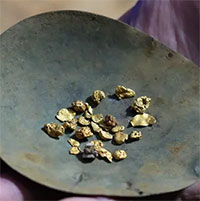This ship is like something out of a sci-fi movie, or drawn with AI, but in fact it is humanity’s first offshore fish farm.

Ocean Farm 1 is mankind’s first offshore fish farm. It can hold a volume of 250,000 cubic meters and withstand a magnitude 12 earthquake. Around 20,000 sensors are fitted allowing it to achieve full automation to feed up to 1.5 million fish in 14 months.
With the aquaculture industry continuously growing and fish farming sites increasingly limited in nearshore areas both in Norway and worldwide, there is a need to develop fish farms suitable for aquaculture. aquaculture in the typical offshore environment is increasing. For this purpose, SALMAR has developed and deployed the Ocean Farm 1 facility for offshore fish farming .

Ocean Farm 1 – the world’s first offshore fish farm – is now in Frohavet. It could represent the first step towards a new era in aquaculture. Based on Norway’s world-class aquaculture and offshore technology, Ocean Farm 1 aspires to solve the central issues related to sustainable growth in the aquaculture industry. As a full-scale pilot facility, Ocean Farm 1 is designed to test both the biological and technological aspects of offshore fish farming.
The structure of Ocean Farm 1 has been innovating. In addition, with this study, it is the first time that a systematic numerical model has been established and used to study farm performance with waves and currents. Similarly, this is also the first time the results of model testing of this structure have been published.
The Ocean Farm 1 structure was tested at SINTEF Ocean’s laboratory in 2014. Digital modeling of the Ocean Farm 1 structure was also performed at SINTEF Ocean, to investigate the response of the fish farm in the environment. sea.

In 2030, the world needs to produce 70% more food, and we need to do so using fewer resources while minimizing our environmental impact. While the oceans cover more than two-thirds of the Earth’s surface, currently only 2% of human food production comes from the sea. In fact, producing animal protein from aquaculture is less resource-intensive and more climate-friendly than raising livestock. Since traditional fisheries have been largely exploited, increasing aquaculture production should play an important role in efforts to feed future generations.
Ocean Farm 1 was built by the China Shipbuilding Industry Corporation (CSIS) in Qingdao, China and was located in an open sea off the coast of Frohavet in Central Norway in the fall of 2017. Since then, two production cycles have been completed, delivering 10,000 tons of high-quality salmon to the market.
Olav-Andreas Ervik, managing director of SalMar Ocean, the division responsible for the offshore business, said: “We were able to observe strong biological results at Ocean Farm 1, with an increasing rate of growth. strong growth, low mortality, low levels of sea lice and production costs on par with the best coastal location.”

The Norwegian Ministry of Fisheries and Coastal Affairs recently decided to award development permits for aquaculture purposes. The goal is to promote new technologies that can ensure adequate growth while ensuring environmental sustainability. The Ocean Farm project is an answer to this challenge and SalMar is the first seafood producer in Norway to be awarded this type of development license.
Ocean Farm 1 is expected to operate at full capacity in the spring of 2023. According to the latest report on “State of World Fisheries and Aquaculture” by the Food and Agriculture Organization of the United Nations (FAO) , global aquaculture production will reach a record 122.6 million tons in 2020, with a total value of 1.5 billion.
Total aquaculture production is expected to reach 202 million tons by 2030, mainly thanks to the sustainable growth of aquaculture, which is expected to reach 106 million tons by 2030.
Aquaculture plays a key role in FAO’s 2022-2031 Strategic Framework, which aims to support 35-40 percent growth in global aquaculture by 2030.

Behind the project is a unique interdisciplinary collaboration between the world’s leading organizations in Norway in the fields of aquaculture, offshore and marine research. The result is a structure built on the robust technology and principles used in offshore submersible installations, while protecting the biological needs of the salmon. When developing technical solutions, every fish farming process was considered and new approaches were established for different operating procedures. The structure complies with aquaculture industry-specific manufacturing standards, as well as relevant offshore oil and gas standards.

Ocean Farm 1 is a full-scale pilot facility for testing, learning, research and development. It will be equipped for R&D activities, with a particular focus on biological conditions and fish welfare. With the goal of reducing environmental pollution, improving fish welfare and addressing acreage challenges, the solutions learned and new from the project could represent a new era in sustainable seafood production. – and worldwide adaptability.

The company behind Ocean Farm 1 is Ocean Farming AS, a subsidiary of the SalMar Group. Ocean Farming was established specifically to develop offshore fish farming capabilities.

